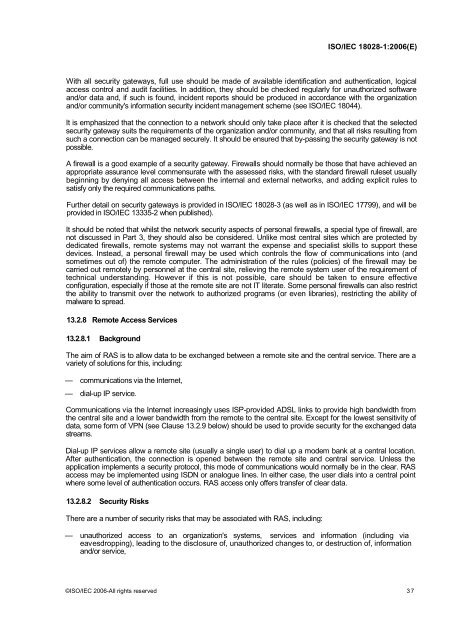INTERNATIONAL ISO/IEC STANDARD 18028-1
INTERNATIONAL ISO/IEC STANDARD 18028-1
INTERNATIONAL ISO/IEC STANDARD 18028-1
- No tags were found...
You also want an ePaper? Increase the reach of your titles
YUMPU automatically turns print PDFs into web optimized ePapers that Google loves.
<strong>ISO</strong>/<strong>IEC</strong> <strong>18028</strong>-1:2006(E)With all security gateways, full use should be made of available identification and authentication, logicalaccess control and audit facilities. In addition, they should be checked regularly for unauthorized softwareand/or data and, if such is found, incident reports should be produced in accordance with the organizationand/or community's information security incident management scheme (see <strong>ISO</strong>/<strong>IEC</strong> 18044).It is emphasized that the connection to a network should only take place after it is checked that the selectedsecurity gateway suits the requirements of the organization and/or community, and that all risks resulting fromsuch a connection can be managed securely. It should be ensured that by-passing the security gateway is notpossible.A firewall is a good example of a security gateway. Firewalls should normally be those that have achieved anappropriate assurance level commensurate with the assessed risks, with the standard firewall ruleset usuallybeginning by denying all access between the internal and external networks, and adding explicit rules tosatisfy only the required communications paths.Further detail on security gateways is provided in <strong>ISO</strong>/<strong>IEC</strong> <strong>18028</strong>-3 (as well as in <strong>ISO</strong>/<strong>IEC</strong> 17799), and will beprovided in <strong>ISO</strong>/<strong>IEC</strong> 13335-2 when published).It should be noted that whilst the network security aspects of personal firewalls, a special type of firewall, arenot discussed in Part 3, they should also be considered. Unlike most central sites which are protected bydedicated firewalls, remote systems may not warrant the expense and specialist skills to support thesedevices. Instead, a personal firewall may be used which controls the flow of communications into (andsometimes out of) the remote computer. The administration of the rules (policies) of the firewall may becarried out remotely by personnel at the central site, relieving the remote system user of the requirement oftechnical understanding. However if this is not possible, care should be taken to ensure effectiveconfiguration, especially if those at the remote site are not IT literate. Some personal firewalls can also restrictthe ability to transmit over the network to authorized programs (or even libraries), restricting the ability ofmalware to spread.13.2.8 Remote Access Services13.2.8.1 BackgroundThe aim of RAS is to allow data to be exchanged between a remote site and the central service. There are avariety of solutions for this, including:— communications via the Internet,— dial-up IP service.Communications via the Internet increasingly uses ISP-provided ADSL links to provide high bandwidth fromthe central site and a lower bandwidth from the remote to the central site. Except for the lowest sensitivity ofdata, some form of VPN (see Clause 13.2.9 below) should be used to provide security for the exchanged datastreams.Dial-up IP services allow a remote site (usually a single user) to dial up a modem bank at a central location.After authentication, the connection is opened between the remote site and central service. Unless theapplication implements a security protocol, this mode of communications would normally be in the clear. RASaccess may be implemented using ISDN or analogue lines. In either case, the user dials into a central pointwhere some level of authentication occurs. RAS access only offers transfer of clear data.13.2.8.2 Security RisksThere are a number of security risks that may be associated with RAS, including:— unauthorized access to an organization's systems, services and information (including viaeavesdropping), leading to the disclosure of, unauthorized changes to, or destruction of, informationand/or service,©<strong>ISO</strong>/<strong>IEC</strong> 2006-All rights reserved 37
















